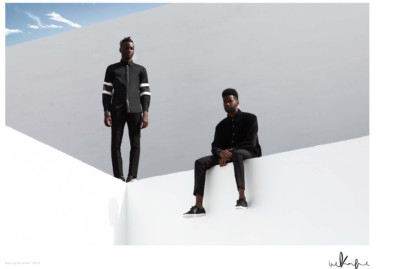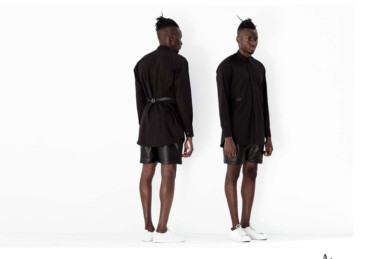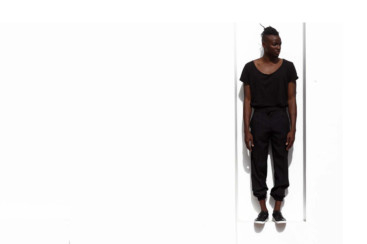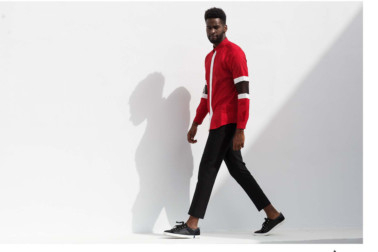
Dubai designer Wekafore Jibril will be the first to tell you: Branding yourself as a ‘fashion designer’, especially in the UAE, is easy.
“Thanks to the internet, all they have to do is put it in their Instagram bio and copy a trend and put it out,” says the 20-year-old who launched his eponymous menswear label in 2013 with partner Abdul-Jelil Adams.
But the real work, he says, is actually trying to build a label from the ground up. “I literally created something out of nothing,” he says.
Jibril began designing in school when he drew on T-shirts with markers and sold them to his classmates for lunch money. Now, three collections in, the biggest challenge for his street wear label is still finances, he adds.
Yet for the Nigerian-born Jibril, who is also a model and a member of Dubai music collective Marsuvees Black, staying true to one’s roots and founding philosophies takes precedence over fast-success and quick internet fame.
Slowly but steadily, his made-in-the-UAE fashion label has been building its fanbase. It’s still a struggle, he admits in an interview with The Directory, but the future is bright.
Take us back to the start. How did it all begin for Wekafore?
The Wekafore brand officially started in late 2013 after about two years of beating around the bush trying to really find out exactly what I wanted to do. We used to have a T-shirt line called ‘White chocolate’ which was based around the idea of something really sweet and smooth — pink, brown and cream were the primary colours. After about a year of doing that I decided to discontinue it and move on to something more mature. The Wekafore brand is basically a transparent depiction of my not-so-colourful imagination, it is a never-ending pursuit of modernism and aesthetical excellence. It grows just as we grow.
Why did you think the UAE was ready for such a fashion label?
I see living in a country or a city just as an artist painting on a canvas. You see Milan, Paris, Hong Kong, New York… these are all canvases and we as inhabitants are artists. There are two kinds of people: A) People who come to paint B) People who come to enjoy the sight of what has already been painted. We can collectively paint the city in whatever light we want. The UAE is still a quite empty canvas, that is, there’s still a lot of empty spaces because people are not painting.
I saw that we lack a lifestyle brand (lifestyle because its bigger than just clothes, it is an idea, a state of mind, a way of life) that truly represents the youth, that represents Deira and also represents Jumeirah and Sharjah and Downtown Dubai. People might say Dubai and UAE is a culture-less society, but I think it’s our job to create a culture, a legacy. Just like [His Highness] Shaikh Mohammad [Bin Rashid Al Maktoum, Vice-President and Prime Minister of the UAE and Ruler of Dubai].
Was it difficult starting a fashion label in the UAE?
For us, it was relatively hard as I had no money and everything had to grow organically. It was hard for people to take me seriously (I think a lot of people still don’t). No one wants to listen to the young black kid. Our biggest challenge was and still is finances, we don’t necessarily create to our outmost potential, we create what we can afford to.
How has the reception been so far?
The reception has been really blurry, most people love the idea (or at least they act like they do), and some people still don’t get it. It’s hard to introduce something different from the norm and convince people to think differently, but I think we are up for that task and we are going to keep pushing that envelope.
Where do you source your materials? Where do you produce the clothes?
Some of our fabrics are sourced here in the UAE and some from Indonesia. All the pieces are produced locally, producing abroad would go against our code of ethics for now as a Dubai-bred brand.
What are your price points and how did you decide on pricing?
Our prices range from Dh200 to Dh1,200. We try to be as honest as possible with pricing in order to communicate to active young people just like myself. Contrary to popular belief, when it comes to design and fashion, I don’t believe price is directly proportionate to value.
From your experience, how has the menswear market in general evolved?
I think in the past two to three years there’s been a tremendous influx of street-wear and street-style. Suddenly, it’s the norm. Now people wear trench coats and ripped denim pants with a $500 sneaker and call it street-style. Street wear used to be for broke people. When I was a kid, the only people who used to rock street-wear were the black American rappers that I used to idolise with the durags and bandanas and baggy pants and Air force 1’s. Now everyone is doing street-wear and it has lost its meaning in a good way because there’s less of a social barrier now when it comes to the hierarchy of high-end, high-street. Everyone can meet at the middle now. God bless Zara.
What about menswear in the Middle East?
Menswear in the Middle East is no different. As far as the youth go, we all follow the trends, but I hope we’ll be able to create our own bubble where we do our own thing and have our own circle. That’ll be sick.
Are you only planning to stick with menswear?
Our main focus would always be menswear, even though we will put out one or two female looks every collection. I’m not a big fan of the girly, glamorous, incredibly high-heel wearing woman. I think the typical Middle Eastern woman is way too fancy for me.
Where would you like to take the label?
We would love to get Wekafore into top retail stores, and eventually open our own store so we could really control the price points and communicate at a level where we want to. For now we just want to grow and mature our aesthetic, put out solid pieces and go from there.
Go get yours
Wekafore is available online on wekafore.com

















